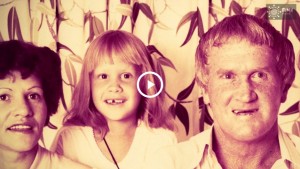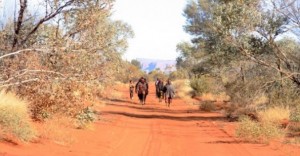Aboriginal Radio in Australia
Magdalena Rausch
Australian Aboriginal families were forcefully separated and sedentarized in an area of thousands of square kilometers during colonization. A community cannot persist over these distances without the help of specific social tools. The production of Aboriginal media helps gathering a locally dispersed community into a shared collective, re-crafting intra-indigenous connections (Fisher 2013: 380). This post will give you some short insights into how this is valid for today’s Aboriginal media.
Media can transcend boundaries of time, space and language. It can help construct identities that link past and present, thereby reproducing and transforming cultural identity among people who have experienced massive political, geographic and economic disruption (Ginsburg 1991: 94). At the same time there are great intra-indigenous variations due to different experiences with colonization, settlement, urbanization and long-standing forms of localised affiliation and identification (Fisher 2013: 379).
This post will try to hint at this diversity by introducing two very different media companies and their radio programs. As a German student who has never been in touch with an Aboriginal community – in fact, never even been to Australia – my access to the field was very limited. I almost feel like one of the old armchair ethnologists, except that I have been able to enrich the knowledge I obtained from different ethnographic texts with various information provided online by the Aboriginal stations themselves. Thus, what I can do is to present you some interesting aspects I found online and season them with some thoughts from scientific texts.
I would like to begin with introducing you to 4AAA 98.9 For the Best Country. It’s a Brisbane based station and part of the Brisbane Indigenous Media Association (BIMA) which also holds a multi media center and a media technology training program. As you can guess from their name, their program offers mostly country music, when they’re not playing charts, blues, bluegrass or their Murri hour with the “best Indigenous music from around the country”. Also, they cover all games from the Australian Football League. Tuning in to 98.9 For the Best Country and finding yourself listening to football game broadcasts or country or charts music can give you a feeling for contemporary Aboriginal realities – where “old” and “new” cultural interests fuse into what might be called an Aboriginal modernity?
The term indigenous media brings with it several issues related to different aspects of the negotiation of indigeneity. For example, Faye Ginsburg, one of the most influential media anthropologists, has pointed out that the term suggests a homogeneity of producers, consumers and indigenous groups which does not reflect empirical reality (Ginsburg 1994: 366). Issues about the negotiation of indigeneity itself, namely what it means to be Black, are also tackled by 4AAA in their Smashing The Myths radio messages and the BIMA with their BLACK IS videos. Nadine McDonald-Dowd explains in the video below that being Black isn’t a matter of skin tone to her. Just click on the picture and you will be connected to BIMA’s website.
Many anthropological studies about Aboriginal radio describe how radio is used to reconnect families and communities that were forcefully segregated and sedentarized in small remote towns in the 1940s. With the rise of Aboriginal Media activism since the 1980s, certain kinship addresses that are iconic for Aboriginal Australia are used to make radio ‘sound’ indigenous, distinct from colonizers’ culture and thereby marking a valued indigenous difference (Fisher 2013: 378). The notion of kinship refers not only to a person’s family, but also functions as a “sociocentric means of reckoning relatedness within and between communities” (377). Radio speech then includes certain Aboriginal English expressions, such as “you mob”, us blackfellas”, and openings such as “how ya goin’ bruz,” “g’day brother,” or “g’day sis” (Fisher 2009: 294). You can easily experience the common use of this practice by listening to 98.9 any time.
As Daniel Fisher describes in his study of 4AAA, radio functions as a way of “linking people up, an idea stemming from a two-decade-old project of re-connecting dispersed families and communities” that is still very important today. Families continue to be violently separated as many Aboriginal men are imprisoned, often for small crimes that would only result in a monetary penalty for white men, says Fisher (2009: 281). Voice recordings of imprisoned persons counter a racist discourse of indigenous criminality by making prisoners individual subjects with family ties (ibid.). The importance of listeners calling into the station and dedicating messages or songs to their families and communities continues even in times of digital, pre-recorded radio. 98.9 For the Best country offers a weekly request show every sunday evening for “talking up community issues and connecting people through music requests”.
Indigenous media can be as diverse as indigenous life itself. It reaches from low budget productions by individuals and small media associations to artistic productions displayed at globally important festivals, encompassing legal or health advice advertisements to approve indigenous everyday life in often marginalized communities and many more (Ginsburg 1994: 366). An example for such videos allows me to introdue you to the second example, the PAW Media association, localized in Yuendmundu in Central Australia. The name is short for Pintupi Anmatyerre Walpiri Radio Network and their radio station is heard in 14 communities across 450,000 square kilometers, with 10 radio studios linking through our Yuendumu radio hub.
[jwplayer mediaid=”531″]
Browsing PAW Media’s website, you can find plenty of content in Aboriginal languages, which marks a very big difference to 4AAA. For example, check out Nyiyaku Kanparla Warrirni, a poem produced by the Bilingual Resource Development Unit of Yuendumu or the oral history project Yapa Patu Wangkami. These projects may be a result of PAW media’s history. Let us quickly dive into it before continuing to look at the association today: In 1971, the newly elected Australian government terminated the politics of forced assimilation and gave Aboriginal communities more room for self-determination and self-management (Hinkson 2012: 144). With this change, an Aboriginal “cultural renaissance” and a new Aboriginal media activism emerged (ibid.). In the early 1980s, several Aboriginal media associations offered alternative programs to the spreading mass media which, as many feared, would irreversibly erode traditional languages and cultures, replacing them with alien social values and Western attraction to consumer goods (Ginsburg 1991: 97). PAW Media, formerly called the Walpiri Media Association, was part of this development. American anthropologist Eric Michaels, working for the former Australian Institute of Aboriginal Studies, introduced media production to Yuenmundu by motivating people to produce their own films without imposing Western conventions of shooting and editing (Hinkson: 2012 144; Ginsburg 1994: 371). Tapes recorded in that time demonstrate how media can be fashioned and used in ways appropriate to native social organization, narrative conventions and communicative strategies, describes Ginsburg, who also did research in the same town some 10 years after Michaels (Ginsburg 1991: 99).
Today, PAW media describe themselves as a “platform for sharing local language, local music and local stories”, “working with local people in language and according to local cultural protocols we create unique Aboriginal media productions” (source, 28.09.2015). Their focus becomes clear once again in projects like the award winning radio documentation When We Walked about two 9 day community walks “aimed to support both physical and cultural health, giving people a chance to spend time out on their country, and to walk and be active every day”. “The documentary captures the experiences and feelings of the walkers; many are following the footsteps of their grandparents and ancestors.” (source, 28.09.2015) It was recorded in Walpiri but you can listen to a translated version online. It’s a wonderful hearing experience I highly recommend. Click on the image below and you’ll be directed to the recording:
As we have seen, Aboriginal ways of producing media to support their communities can be very different. 98.9 For the best country presents its audience plenty of ‘non-traditional’ country, blues and charts music and sports game broadcasts. PAW media focuses more on preserving ‘traditional’ language and cultural practices. Both examples represent approaches to what Aboriginality can mean in the 21st century. However, what has become clear in both examples is that Aboriginal media production is very vivid up to this day.
Literature:
Fisher, D. (2009): Mediating Kinship. Country, Family, and Radio in Northern Australia, Cultural Anthropology, Vol. 24, No. 2, pp. 280-312.
Fisher, D. (2013): Intimacy and Self-Abstraction. Radio as New Media in Aboriginal Australia, Culture, Theory and Critique, Vol. 54, No. 3, pp. 372-393.
Ginsburg, F. (1991): Indigenous Media. Faustian Contract or Global Village?, Cultural Anthropology, Vol. 6, No. 1, pp. 92-112)
Ginsburg, F. (1994): Embedded Aesthetics. Discursive Spaces for Indigenous Media, Cultural Anthropology, Vol. 9, No. 3, pp. 365-382.
Hinkson, M. (2012): The Cultural Politics of Radio. Two Views from the Walpiri Public Space, in: Bessire, L./Fisher, D.: Radio Fields. Anthropology and Wireless Sound in the 21st Century, New York.
https://www.pawmedia.com.au/





 Die
Die
Am 18. February 2023 um 12:30 Uhr
Dear fu-berlin.de admin, Your posts are always well researched.